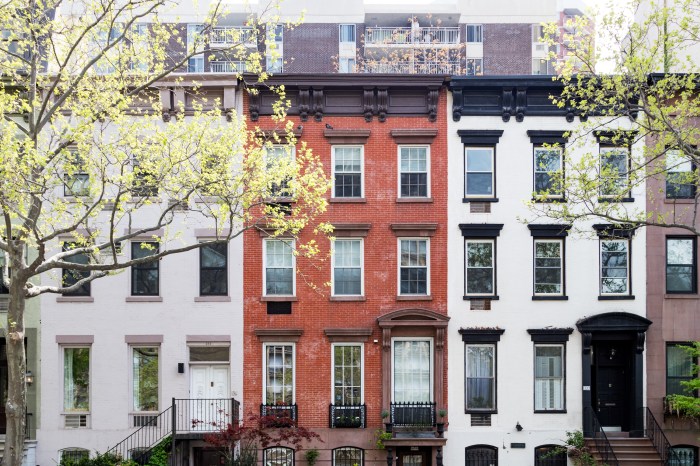 BY MICHELE HERMAN | This country is rich in vernacular early 20th-century architectural styles. You can wander into any city or town and instantly recognize the post office, the elementary school, the movie house. But what about the lowly urban garage? You know the one I mean. It’s one or two stories high but very wide, brick or stucco. It has bays and large multi-paned windows and a symmetrical parapet line, with a series of Dutch steps or simple pediments. There are quite possibly some diamond-shaped details up high on the facade to add a little pizzazz.
BY MICHELE HERMAN | This country is rich in vernacular early 20th-century architectural styles. You can wander into any city or town and instantly recognize the post office, the elementary school, the movie house. But what about the lowly urban garage? You know the one I mean. It’s one or two stories high but very wide, brick or stucco. It has bays and large multi-paned windows and a symmetrical parapet line, with a series of Dutch steps or simple pediments. There are quite possibly some diamond-shaped details up high on the facade to add a little pizzazz.
The far West Village still has a fair number of these humble but quite pleasing garage buildings. They don’t get a lot of love. Across the five blocks of Jane St., within the Greenwich Village Historic District, you will find two. To the west is the pair of contiguous little red buildings that until recently housed Pro Piano and to the east is a whitewashed parking garage still in operation.
Both of these properties have recently been sold. The new owner of the Pro Piano property, who bought it for a reported $35 million, is planning a five-story, 80-foot-high, 15,000-square-foot single-family home. The rumored plan for the white garage, bought for $26 million, is a six-story building with a couple of townhouses and apartments and a gym. If recent experience is a guide, the Landmarks Preservation Commission will dicker with the developers about facade details, ask them to shave a little off the ceiling heights, and grant the rest.
New York has been a developer’s paradise for centuries. Real estate pressures in the Village are intense. So I probably should get over feeling like I’ve been punched in the gut each time a developer buys up a piece of the city’s historic fabric as a teardown. Sometimes I think there’s even something first-world and knee jerk and suspect in my devotion to old buildings that may have outlived their useful life; surely, there are more important battles I could be fighting.
But the past couple of days I’ve been walking the dog across Jane St. from the red garage to the white one. And the more I look at these buildings, the more important and even poignant they seem, and the more I feel compelled to push back against their destruction. This is only in part because I love Jane St. so much — charming, tree-canopied, all-of-a-piece, slightly overripe Jane St., where my husband and I set up our first household on its raggedy western edge in the ’80s.
I got to thinking about early 20th-century garage style and about why these structures move me so, particularly when compared with the monstrous parking garages of the second half of the century. I started googling to learn more and hit gold: a Columbia master’s thesis entitled “Manhattan Parking Garages 1897-1930: Significance and Preservation” (Hilary Grossman, 2013).
As I came to find out, these garage buildings are packed tight with history. They harken back to a largely forgotten period of American history when, practically overnight, the automobile overtook the horse and buggy. Between 1907 and 1917, New York was transformed so thoroughly that all the city’s horse stables were either demolished or converted and this wholly new building type proliferated.
As Grossman explains, the automobile’s advent was considered a vast environmental breakthrough in a poop-saturated city. In the year 1900 alone, the city counted — don’t ask me how — 750,000 “horse accidents.” I think of my great aunt Dora, who called cars “machines.” How whiplashed her generation must have felt by change, much as we early 21st-century dwellers feel about our “devices.”
It took a while for Americans even to come up with a word to describe buildings that stored cars. They were known as automobile stables until someone exported the French word “garer” (to dock). During that period, people were trying to figure out how this new culture would work. Cars and horses couldn’t coexist in a stable, even though the infrastructure of ramps and elevators and stalls suited both; the exhaust and noise scared the horses and the ammonia used to clean the stalls tarnished the cars.
Around 1916, the purpose-built two-story garage type emerged. Modest as their exteriors were, these structures were quite modern inside, with clever ramps, elevators and turntable systems and some of the first steel-reinforced concrete slabs. At first, they tended to serve every car-related function — gas station, paint shop, sales room; a mechanic and his family probably lived upstairs. Then, when the Model T came along and cars became cheaper to run than horses, landlords kept the lucrative cars and kicked out everyone else.
The one-story Pro Piano garage building dates to 1919, smack in the middle of this era. The contiguous two-story building (actually two buildings) is from 1892, and has been a stable, a garage and a factory. My mother-in-law, who worked as a day-camp counselor at Greenwich House in the 1940s, vividly remembers taking her campers there for ice cream when it was a Borden’s factory.
Over at the eastern end of Jane St., the white garage dates to 1921. According to the Landmarks report, it was built for the New York Society of the Methodist Episcopal Church, on the site of a church that dated to the 1840s. I’m still trying to ascertain whether, as I suspect, this garage has been in continuous use its entire life, a claim few commercial buildings in this city can boast.
Like most of the systems that govern us, the landmarking process is wildly imperfect. Obviously, the city cannot save all structures with aesthetic and historical significance, and obviously someone has to make the calls. My question is the same one that’s being so widely asked about our national politics: Is the system flawed or is it rigged?
My sense is that developers are growing increasingly nervy and reckless. They buy up the remaining low-lying commercial properties within historic districts for wildly inflated prices, confident they will get the blessing of the L.P.C. to ram through demolitions. Call it the “noncontributing building” loophole — under which developers argue that certain buildings don’t contribute to a given district’s historical integrity.
We’ve seen it in the recent hearings about Gansevoort St., and we are about to see it on Jane St.
These garage buildings may be humble, but they clearly contributed plenty to the history and aesthetics of this city. I’m not as cynical as many. But if Landmarks rubberstamps another pair of luxury residential developments in these two garages’ place, I say the system is rigged.

















